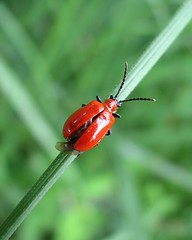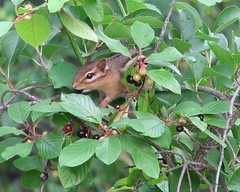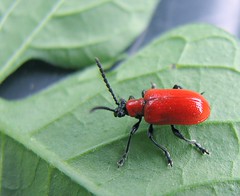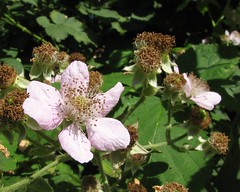Sorry, have to go off on a local rant here. Maybe folks from outside of New England will stick around just to sympathize...
[rant]
Last month the Massachusetts legislature approved two big, fat, multi-million dollar pork-filled spending bills. In one of the bills was $150,000 earmarked for a program to develop a biological control program (.pdf) for the European winter moth (Operophtera brumata) that has been causing massive tree defoliations up and down the Massachusetts coast. The moth populations exploded a couple of years ago and have been gradually spreading inland (plenty of them last winter at my house in MetroWest Framingham).
My beef is not so much with Governor Romney's subsequent line item veto of the money, but the way it was handled. Here is Gov. Romney's response when asked about the veto:
"No one came up to me and said 'Hey look, this is so important,'" Romney said on Saturday. "If it's that important, UMass ought to be able to find a way to pay for that in their normal budget."
What an uninformed response! UMass Amherst and their Cooperative Extensions program have been at the forefront of educational outreach for the winter moth invasion since the problem first became known. They should be congratulated, not shamed. As Dr. Elkinton, the lead scientist for the proposed program, noted in an interview over at BostonChannel.com, "This is a threat to the entire state of Massachusetts." Implying that the program is something UMass Amherst should pay for is ridiculous.
As if Gov. Romney's response wasn't embarrassing enough, Boston Herald columnist Howie Carr had to get into the mix. From his June 28th column in the Boston Herald:
"But what’s Mitt supposed to do when they pass these lard-ridden budgets? Consider the $150,000 to UMass to study the winter moth. Out in Happy Valley, this is being portrayed as the new Manhattan Project, but the reality is, everything you need to know about moths can be summed up in two words.Moth balls.
You buy enough moth balls, and you won’t have to worry about the winter moth, or the summer moth either, for that matter."
Wha??? Howie, please. It's one thing for the Governor to make an off-the-cuff snide remark, but if you're going to write about a topic in your column, please do some fact-checking. The fumes from moth balls only work if they can build up inside sealed containers. They aren't going to do a darned thing for the winter moth caterpillars devouring your trees. I found this out in five minutes with some help from Google, apparently more effort than you were willing to put into learning about it.
With over $200 million in pork projects, why is the winter moth being scapegoated? Maybe because the impact of the moth isn't being felt that far inland yet. The Senator and Representative that earmarked the money are from coastal towns of Gloucester and Falmouth, respectively. I have a feeling when people in Wellesley (Howie!) and Belmont (Mitt!) start noticing that none of their trees have leaves, and their houses and cars are covered in caterpillar poop, they will start paying attention. That shouldn't be too long from now, since we're already seeing high numbers of moths inland. Unfortunately, repeated defoliation of trees leads to...you guessed it: tree mortality. Winter moths aren't picky either - they'll go for oaks, maples, cherries, and even spruce trees.
The extent of the invasion and the difficulty in distinguishing the European winter moth from several similar but native species means that the chance of eradicating them, if it was ever possible, has long since passed. Perhaps a biological control program modeled after successful programs in Canada is exactly what we should be aiming for.
[/rant]
The ISW previously blogged about the European winter moth in April 2005 and May 2003.




